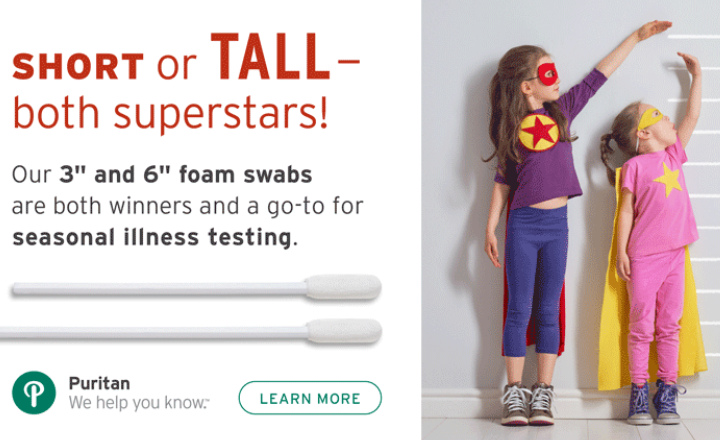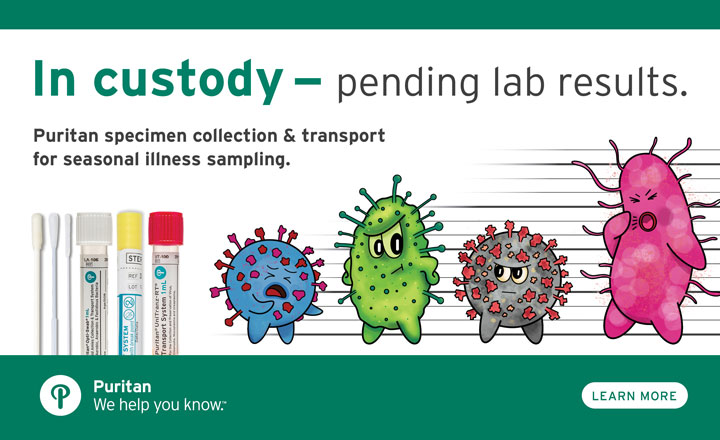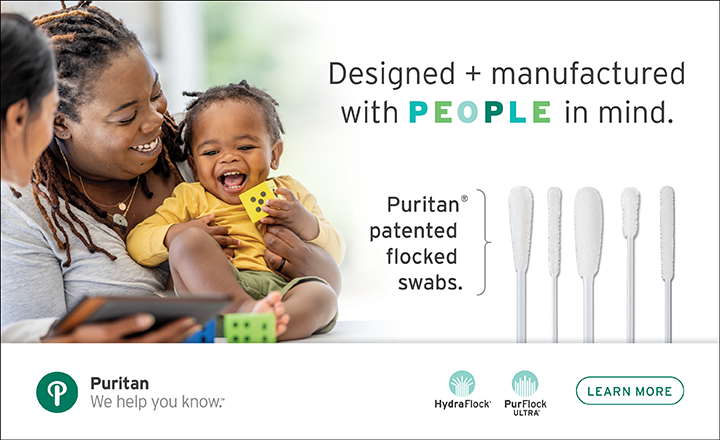With the current rise in flu cases and possible spread of emerging respiratory viruses, like the novel coronavirus (2019-nCoV), laboratories and healthcare providers can expect another very busy flu season. The 2019-2020 flu season is on track to be one of the worst in years and is estimated to be similar in severity to the 2017-2018 flu season. By the end of that 2017–2018 season, the Centers for Disease Control (CDC) reported that the total burden of illness showed an estimated 48.8 million people became ill with influenza, 22.7 million people visited a health care provider, there were 959,000 hospitalizations, and 79,400 fatalities.1
Accurate respiratory virus detection is dependent on the quality of the sampling method, storage, and transportation to the testing site. A successful diagnostic test begins at sample collection because improper sampling can result in an inadequate specimen, rendering a diagnostic test inconclusive or incorrect. There are several upper respiratory tract sampling methods currently being utilized prior to testing, including nasopharyngeal aspirates/washes, nasal washes, and a combination of synthetic swabs.
The article “Current Best Practices for Respiratory Virus Testing” published in the Journal of Clinical Microbiology, by Christine Ginocchio and Alexander MacAdam, considers issues in diagnostic testing for respiratory viruses, including best methods for detection, sample handling and testing for antiviral resistance. It is as relevant today as it was in 2011 when it was first published. One of the methods tested was COPAN’s FLOQSwabs® flocked swabs combined with COPAN’s UTM®: Universal Transport Medium (UTM®) as a solution for a superior collection of upper respiratory specimens.
UTM® is an FDA cleared universal transport system suitable for collection, transport, maintenance, and long-term freeze storage of clinical specimens containing viruses, chlamydia and mycoplasma or ureaplasma organisms. The UTM® collection and transport kits consists of two components: one or two FLOQSwabs® or traditional fiber swabs and 1mL or 3 mL of UTM® medium in a self-standing tube capable of maintaining organism viability for 48 hours at room or refrigerated temperature. COPAN’s FLOQSwabs® consist of a molded plastic applicator stick with variable sized tips, anatomically designed, and coated with Nylon® fibers to create a thin absorbent layer that allows for quick specimen uptake and complete specimen elution into COPAN’s UTM®. COPAN soft flocked swabs are easy to use and their anatomic design is less invasive for the patient, when compared to nasopharyngeal washes/aspirates or nasal washes.
The authors of the Best Practices article concluded that COPAN’s nasopharyngeal flocked swabs have been found to yield specimens comparable to the gold standard nasopharyngeal wash for detection of respiratory viruses by NAAT or DNA [2]. Additional clinical studies have also shown that UTM® paired with COPAN FLOQSwabs® significantly outperform the use of traditional nasal aspirates and are comparable to nasopharyngeal aspirates in a variety of PCR-based viral assays and that the COPAN specimens were easier to store, transport and rapidly test [3, 4, 5, 6, 7, 8, 9, 10, 11].
As testing methods evolve, it is important for clinicians to keep current with the techniques like those outlined in the best practice article. Specimen collection should be performed by health care personnel who have completed training and demonstrated competency. Always read the manufacturer’s package insert for specific instruction regarding specimen collection and transport for the type of test kit being used.
COPAN has collaborated with many healthcare professionals to develop free educational videos on sample collection that can provide some of the support you need for specimen collection. Particularly interesting at this point in time, click here to see video demonstrations of proper sample collection techniques for different respiratory samples.
Click here for an in-depth look at nasopharyngeal synthetic flocked swab sample collection practice. A library of scientific studies is also available at COPAN’s website.
The performance of a diagnostic test starts with sound sampling techniques and the quality of the specimen collection and transport device. Having an appropriate and less invasive collection and transport devices like UTM®, enables healthcare professionals to better care for sick patients, while ensuring the integrity of the sample provided to the laboratory. As we continue through our current influenza season, COPAN’s UTM®/ FLOQSwabs® will provide for specimen collections with high sensitivity in diagnostic testing for influenza and other respiratory infections, whether using culture, antigen, or molecular assays.
For References please visit:www.copanusa.com
























